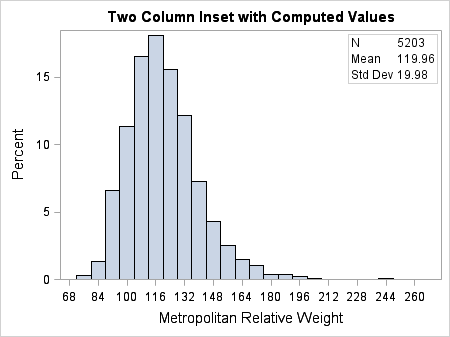Creating an Inset with Values that are Computed in the Template
The examples presented
so far have "hard coded" the statistic values in the compiled template.
Hardcoding the statistic values requires you to change and recompile
the template code whenever the column values change or you want to
use different columns for the analysis. A more flexible way to present
a statistics table is to compute its content as follows:
GTL supplies several functions
that you can use to calculate the statistics, including functions
that match the statistic keywords used by PROC SUMMARY. GTL functions
are always specified within an EVAL function. To declare dynamic variables,
you use the DYNAMIC statement.
The following example uses the
DYNAMIC statement to declare a dynamic variable named VAR, which is
used in the functions N, MEAN, and STDDEV to calculate the statistics
that are displayed in the statistics table:
proc template; define statgraph ginset4a; dynamic VAR; begingraph; entrytitle "Two Column Inset with Computed Values"; layout overlay; histogram VAR ; layout gridded / rows=3 order=columnmajor border=true autoalign=(topleft topright); /* column 1 */ entry halign=left "N"; entry halign=left "Mean"; entry halign=left "Std Dev"; /* column 2 */ entry halign=left eval(strip(put(n(VAR),12.0))) ; entry halign=left eval(strip(put(mean(VAR),12.2))) ; entry halign=left eval(strip(put(stddev(VAR),12.2))) ; endlayout; endlayout; endgraph; end; run; proc sgrender data=sashelp.heart template=ginset4a; dynamic VAR="mrw"; run;
-
On each of the ENTRY statements, the STRIP function strips leading and trailing blanks from the returned values. The PUT function on the first ENTRY statement returns the statistics value with format 12.0, and the next two PUT statements return values with format 12.2. The N, MEAN, and STDDEV functions return the number of observations, mean, and standard deviation of variable VAR.
-
In the SGRENDER procedure, the DYNAMIC statement initializes dynamic VAR so that it resolves at run time to column MRW from the SASHELP.HEART data set. Because the dynamic resolves to a column name, the value that is assigned to it is enclosed in quotation marks. (Values for dynamics that resolve to column names or strings should be quoted. Numeric values should not be quoted.)
